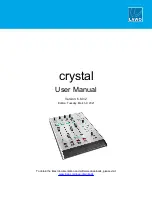
4-14
F-1058-0820
OPERATION AND MAINTENANCE
5110 Transporting the Grain Drill
(Pull Hitch)
Before transporting the grain drill, check the following:
1.
Check and follow all federal, state and local
requirements before transporting the grain drill.
2.
The grain drill should be transported only by a tractor
required for field operation. The implement weight
should not exceed more than 1.5 times the tractor
weight.
3.
Check to see that the tractor drawbar is rated to carry
the weight of the grain drill hitch
4.
Use a locking style hitch pin that properly fits the
holes in the tractor drawbar and implement hitch.
5.
Attach the safety chain to insure safe transport.
a.
The safety chain should have a tensile strength
equal to or greater than the gross weight of the
implement. The chain is attached to the lower
hitch clevis hole with two flat washers between
the clamp plates to assure a tight connection.
Always use a 1” diameter Grade 8 bolt for this
connection.
a.
Attach the safety chain to the tractor drawbar
. Provide only enough slack in
the chain for turning. Do not use an intermediate
chain support as the attaching point for the chain
on the tractor. Do not pull the implement by the
safety chain.
a.
When unhitching from the tractor, attach the
hook end of the chain to a free link close to the
hitch clevis for storage. This will keep the hook
off the ground, reducing corrosion, and keep the
hook functioning correctly.
a.
Regularly inspect the safety chain for worn,
stretched, of broken links and ends. Replace the
safety chain if damaged or deformed in any way.
6.
Raise the implement parking jack, and place in
storage location.
7.
Plug in the safety lights to the tractor seven-pin
connector. Make sure lights, reflectors, and SMV
emblem are clearly visible and functioning properly.
Remove any obstructions such as dirt, mud, stalks or
residue that restricts view before transporting.
8.
Connect the hydraulic hoses. Route and secure the
hydraulic hoses to avoid interference with the
drawbar or three-point hitch. Do not allow the
hydraulic hoses to drag on the ground.
9.
Whenever possible do not transport the drill loaded
with seed. Additional weight increases braking
distances, reduces steering, raises the center of
gravity, and reduces stability.
10.
Do not transport the drill with seed in the native grass
box. The seed can settle packing in around drive
components and causing uneven distribution while
transporting.
11.
Transport during daylight hours whenever possible.
Always use flashing warning lights except where
such use is prohibited by law.
12.
Fully raise the drill for transport.
13.
Raise the drill and place the rear parking stands in
the storage position
.
WARNING
14.
Make sure all transport locks and pins are installed.
DANGER
15.
Know the height and width of the implement being
towed. Markers, tanks, attachments, etc. can
increase the height and width of the implement.
CAUTION
16.
Maximum specified ground speed for the grain drill is
20 mph and is designated on the speed identification
symbol (SIS) located on the front of the grain drill.
a.
Maximum travel speed for the drill is the lesser of
i.
The limit of the road conditions
ii.
The maximum specified ground speed
1.
For towing operations as indicated in the
operator’s manual or SIS.
2.
Of the towed vehicle as indicated in its
operator’ manual, SIS, or information
sign.
b.
The maximum ground speed of the towed
equipment combination shall be limited to the
lowest specified ground speed of any of the
towed machines. This is the ground speed
limitation.
Failure to use transports locks and pins during
transport may result in equipment damage,
serious injury, or death.
Stay away from power lines when transporting,
extending, or folding implement. Electrocution
can occur without direct contact
Excessive speed may result in loss of control of
the tractor and implement, reduced braking, or
failure of the implement tires or structure. Do
not exceed the implement maximum specified
ground speed regardless of the capability of
the maximum tractor speed.
















































